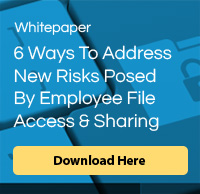As advances in consumer technology make it easier for people to collaborate and stay connected from anywhere, that expectation is steadily trickling into the business environment and its enterprise file sync and share (EFSS) solutions.
Accessibility, productivity and security are driving the EFSS industry, while anywhere, anytime, any device access is the overarching theme behind many of the current and emerging trends in EFSS.
Here are five of the biggest trends in EFSS today:
1 — Content aggregation & anywhere access: Enterprise content management (ECM) systems, such as SharePoint, have long been the go-to data repository for medium- and large-sized organizations. However, SharePoint is not always an organization’s sole data repository. Other file-sharing platforms, such as NAS or Google Drive, could also be used at varying levels across many departments within an organization.
An emerging trend as a result is that EFSS systems are becoming an aggregator of documents across all an organization’s data repositories. By using a secure EFSS platform for aggregating documents in one place and then providing users anytime, anywhere access to those files from any device, IT departments create a productive and flexible experience for the end user while maintaining access control.
2 — Integration with daily workflows: Using Microsoft Outlook for email isn’t a trend — it’s a way of life for most businesses. A trend to watch for in secure EFSS solutions is user-friendly design that ensures an individual’s daily workflow isn’t disrupted by the EFSS
Look for increased integration with Outlook. Compared to unsecured file-sharing through Dropbox or navigating a clunky FTP server to upload documents, allowing end users with enriched experience within Outlook and securely share files is a win for everyone. IT teams get the security and control they need, while end users get an easy and non-disruptive way to share files.
3 — Built-in editing apps: If someone in your organization securely receives a Word document via EFSS but must open that document in an application or program outside of the EFSS system to make edits or annotations, it sets the stage for trouble.
Not only does IT lose control of the file, but also the end user gets frustrated by having to open another app to work on the document. To avoid these workflow disruptions, the EFSS industry is responding with editing and annotation capabilities integrated into EFSS systems that work from both desktop and mobile devices. With built-in editing features, the IT department retains control over access rights to the file and the end user’s workflow isn’t disrupted.
4 — Data containerization & DRM: As bring-your-own-device (BYOD) becomes more common throughout the workplace, IT teams must rely on data containerization to keep enterprise files separate from other data on an employee’s personal device. But what happens when that containerized data gets shared and lands on a device outside of your control?
An EFSS platform without robust digital rights management (DRM) policies means IT departments have limited control over what happens to even containerized data on an employee’s personal device. The latest trend in secure EFSS is embedded DRM, which essentially controls how an individual file behaves upon distribution. As more organizations adopt enterprise file security with data containerization, the next step is to further enhance that file security with DRM. DRM can also keep files safe through policies that restrict file access based on geographic location or IP range.
5 — Integration with content-aware DLP vendors: Data loss prevention (DLP) vendors, such as McAfee and Symantec, are major players in the security Content-aware DLP solutions from these companies help businesses create data classification mechanisms, and the big trend today is integrating those classifications with an EFSS platform. For example, an EFSS platform integrated with a DLP vendor should be able to block files with terms such as “classified” or “confidential” from being distributed beyond a pre-defined list of users. These classifications could also be assigned to flag anything that looks like a credit card number from being copied or forwarded, which is important for organizations that must maintain certain regulatory compliances.
Whether you’re looking to bring a new, secure EFSS solution into your organization or upgrade your existing one, look for an EFSS platform that’s addressing today’s IT and end user demands. Use the above trends as a guide to help you find the right EFSS solution for your needs.

